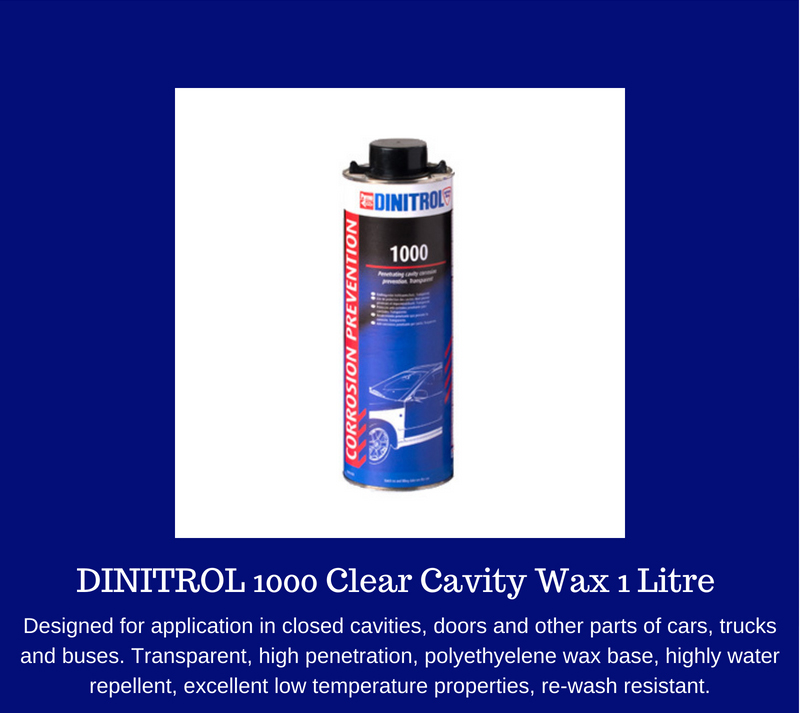16th May 2018
Rust proofing your vehicle?: Cavity waxes most suited to the job
Cavity waxes are formulated to have rust proofing properties but not all have the ability to creep into hard to access areas of a vehicle after application.
DINITROL cavity wax application is a process by which a waxy solution is sprayed inside the box sections of a vehicle. The self healing property of the cavity wax enables it to creep over any area that may have been scratched to reseal it.
DINITROL cavity waxes provide long lasting rust proofing by displacing moisture and penetrating into hairline cracks for additional protection. DINITROL doesn't drip and isn't as messy to apply as some it's well known competitors. Once dry it flexes without cracking.
Rust proofing with DINITROL cavity waxes
DINITROL 3125
- Particularly suitable for use on old vehicles where corrosion is evident.
- It offers a drip free application and dries to leave a brown, hard, waxy film.
- Dinitrol 3125 is ideal for the application to box sections, cavities, door bottoms and windscreen scuttle.
Dinitrol 3125HS cavity wax
- Has similar properties and uses as DINITROL ML. The main difference between them is that 3125HS has a high viscosity. This means that it is very thick and will require warming prior to use.
- Better suited to application in warm weather and can be used as a thin underbody coating where high abrasion is unlikely.
- Penetrates rust and dirt preventing further corrosion. Even damp and dirty surfaces will not affect its superb performance.
DINITROL ML
- A very thin and of low viscosity wax ideal for spraying into the chassis, box sections and hard to reach areas.
- Contains rust inhibitors and will help stop ongoing corrosion by forming a soft, wear resistant film that effectively eliminates dampness.
- An all year round product and doesn't need warming prior to application.
- DINITROL ML was designed to offer the best rust proofing to classic cars or older car models.
- Available in a convenient 500ml aerosol with 90mm straw extension applicator attachment allowing for quick and easy application - so there is no need for a spray gun or compressor.
- The extended nozzle makes it perfect for spraying inside closed cavities such as doors, door sills, frame parts, external joints and cracks. An extension hose can be fitted directly onto the aerosol nozzle for full coverage within enclosed spaces.
- DINITROL ML does not harm lacquers used in the motor industry and adheres well to substrates.
DINITROL 3654
- Its medium viscosity allows it be used in both warm and cold weathers.
- DINITROL 3654 for application in closed cavities, doors and other parts of cars, trucks and buses.
- Designed for use in new build production as it contains less rust inhibitors. Use on vehicles where little or no rust has formed.
DINITROL 1000
- A clear wax with excellent low temperature properties and is re-wash resistant.
- DINITROL 1000 is mainly based on synthetic waxes and corrosion inhibitors. When the solvent has evaporated the product leaves a transparent, waxy, water repellent protective film, giving excellent rust proofing.
- Ideal for application to door skins, bonnets, boot lids and box sections.
- Also offers excellent film building properties on open surfaces.

The application of a cavity wax is an important part of fully rust proofing a vehicle. It is, therefore important that it is applied properly for a long lasting effect. A high pressure application produces a fine spray that enables DINITROL cavity wax to reach all crevices, nooks and crannies.
DINITROL offers an extensive range of rust proofing and rust treatment products, which means that there is a product designed for specific areas of a vehicle for the best outcomes. We hope that this article helped explain the difference between DINITROL cavity waxes and how each can be used in a restoration or rust proofing project.
